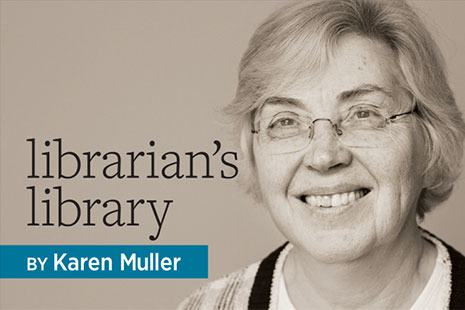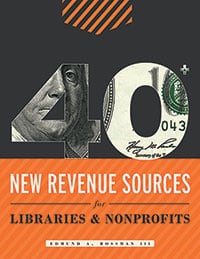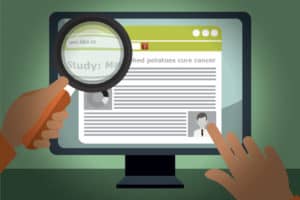
Each year, the American Library Association (ALA) library gets this question from a library science student: “I have an assignment to research an association. What does ALA do?” After explaining our structure and noting the importance of advocacy for funding, good copyright laws, and intellectual freedom, we also detail how Association members assist one another by developing best practices and offering both formal and informal continuing education. Yes, the cocktail-hour sharing of “war stories” can help improve service to patrons. Associations capture and formalize these learnings through publications, and 36% of ALA’s revenue comes from publishing. This column will round up some new books published by ALA Editions, ALA Neal-Schuman, or an ALA division that can help you, the practitioner, do your job better.
 Let’s start with raising money. The first set of chapters in 40+ New Revenue Sources for Libraries and Nonprofits, by Edmund A. Rossman III, lays the foundation for specific discussions about sources. Rossman covers why libraries might need more than what their traditional funding bases offer, which for public libraries is 85%–90% local, and how to establish and leverage value to secure new sources. He covers legal and governance issues, promotional methods (including social media), and the importance of community partnerships. The rest of the book contains minichapters broadly grouped around revenue generation topics: advertising and underwriting; books and materials, such as book sales, equipment rental, and recognizing a donor with a bookplate; naming rights; and sponsorships. ALA Editions, 2016. 248 P. $65. PBK. 978-0-8389-1438-0.
Let’s start with raising money. The first set of chapters in 40+ New Revenue Sources for Libraries and Nonprofits, by Edmund A. Rossman III, lays the foundation for specific discussions about sources. Rossman covers why libraries might need more than what their traditional funding bases offer, which for public libraries is 85%–90% local, and how to establish and leverage value to secure new sources. He covers legal and governance issues, promotional methods (including social media), and the importance of community partnerships. The rest of the book contains minichapters broadly grouped around revenue generation topics: advertising and underwriting; books and materials, such as book sales, equipment rental, and recognizing a donor with a bookplate; naming rights; and sponsorships. ALA Editions, 2016. 248 P. $65. PBK. 978-0-8389-1438-0.
 A component of figuring out the value of your library is scrutinizing existing statistical reports to document positive outcomes. Statistical data can also be used to target areas for improvement. In Library Improvement through Data Analytics, Lesley S. J. Farmer and Alan M. Safer explain the value of data-driven decision making, specifically using the Six Sigma model. They outline the steps of the model—defining the project, measuring the current output, reviewing the process, implementing a change in the process, and controlling and extending the process when improvement is documented. They conclude with case studies and a statistical primer. ALA Neal-Schuman, 2016. 184 P. $75. PBK. 978-0-8389-1425-0.
A component of figuring out the value of your library is scrutinizing existing statistical reports to document positive outcomes. Statistical data can also be used to target areas for improvement. In Library Improvement through Data Analytics, Lesley S. J. Farmer and Alan M. Safer explain the value of data-driven decision making, specifically using the Six Sigma model. They outline the steps of the model—defining the project, measuring the current output, reviewing the process, implementing a change in the process, and controlling and extending the process when improvement is documented. They conclude with case studies and a statistical primer. ALA Neal-Schuman, 2016. 184 P. $75. PBK. 978-0-8389-1425-0.
 This is all well and good, but what about people? Marie L. Radford and Gary P. Radford address just that in Library Conversations: Reclaiming Interpersonal Communication Theory for Understanding Professional Encounters. We have hundreds of interpersonal communications in a day—on the phone, at the reference desk, in a meeting with one’s boss, in the technical processing workroom. The quality of those interactions affects the library’s overall service delivery. The authors review why good interchanges are strategically important and explore them in the context of several communication theories, looking at what is communicated and how it is communicated. The second part of the book applies the principles to face-to-face and chat reference encounters. ALA Neal-Schuman, 2017. 184 P. $75. PBK. 978-0-8389-1484-7.
This is all well and good, but what about people? Marie L. Radford and Gary P. Radford address just that in Library Conversations: Reclaiming Interpersonal Communication Theory for Understanding Professional Encounters. We have hundreds of interpersonal communications in a day—on the phone, at the reference desk, in a meeting with one’s boss, in the technical processing workroom. The quality of those interactions affects the library’s overall service delivery. The authors review why good interchanges are strategically important and explore them in the context of several communication theories, looking at what is communicated and how it is communicated. The second part of the book applies the principles to face-to-face and chat reference encounters. ALA Neal-Schuman, 2017. 184 P. $75. PBK. 978-0-8389-1484-7.
 When Becoming a Media Mentor: A Guide for Working with Children and Families hit my desk, I had to find out what a “media mentor” is. According to authors Claudia Haines, Cen Campbell, and the Association for Library Service to Children (ALSC), a media mentor “supports the literacy, information, and media needs of children, teens, and their families.” It extends the reference interview or readers’ advisory conversation into the broader digital arena of online resources, audio and textual media, games and computer programs, and more. It broadens a librarian’s expertise from just books into new ways of connecting children to information or entertainment. In addition to describing what media mentors do, the book covers the professional development needed to hone the new skills and offers an array of sample programs. An appendix offers the ALSC white paper Media Mentorship in Libraries Serving Youth. ALA Editions, 2016. 176 P. $48. PBK. 978-0-8389-1463-2. (Also available as an ebook.)
When Becoming a Media Mentor: A Guide for Working with Children and Families hit my desk, I had to find out what a “media mentor” is. According to authors Claudia Haines, Cen Campbell, and the Association for Library Service to Children (ALSC), a media mentor “supports the literacy, information, and media needs of children, teens, and their families.” It extends the reference interview or readers’ advisory conversation into the broader digital arena of online resources, audio and textual media, games and computer programs, and more. It broadens a librarian’s expertise from just books into new ways of connecting children to information or entertainment. In addition to describing what media mentors do, the book covers the professional development needed to hone the new skills and offers an array of sample programs. An appendix offers the ALSC white paper Media Mentorship in Libraries Serving Youth. ALA Editions, 2016. 176 P. $48. PBK. 978-0-8389-1463-2. (Also available as an ebook.)
 In Collaborating for Impact: Special Collections and Liaison Librarian Partnerships, editors Kristen Totleben and Lori Birrell bring together a number of practitioner essays on the topic of using special collections held by colleges and universities for research and teaching. Following a discussion of the nature of special collections and institutional repositories and the importance of object-based pedagogy, particularly for the humanities, the case studies are grouped around collection stewardship; projects, research, and exhibitions; and instruction. Although the case studies are all at the post-secondary level, the principles included could benefit school–public library partnerships for hands-on instruction using artifacts from local history collections. Association of College and Research Libraries, 2016. 284 P. $60. PBK. 978-0-8389-8883-1. (Also available as an ebook.)
In Collaborating for Impact: Special Collections and Liaison Librarian Partnerships, editors Kristen Totleben and Lori Birrell bring together a number of practitioner essays on the topic of using special collections held by colleges and universities for research and teaching. Following a discussion of the nature of special collections and institutional repositories and the importance of object-based pedagogy, particularly for the humanities, the case studies are grouped around collection stewardship; projects, research, and exhibitions; and instruction. Although the case studies are all at the post-secondary level, the principles included could benefit school–public library partnerships for hands-on instruction using artifacts from local history collections. Association of College and Research Libraries, 2016. 284 P. $60. PBK. 978-0-8389-8883-1. (Also available as an ebook.)
 Are we finally to a book on books? Yes! Brad Hooper, longtime adult books editor for Booklist, applies his decades of experience with book talks, book discussions, and authors in The Librarian’s Guide to Book Programs and Author Events. Hooper starts with public speaking, the foundation for doing an author talk or moderating an author panel. He moves on to book clubs and reading groups, covering their history, development, and popularity in one chapter and best practices for ensuring good discussion in the next. Other chapters cover programs that feature a single author, those with a panel of authors, writers-in-residence programs, awards, and one city/one book programs, which are also popular with churches, colleges, and conferences. ALA Editions, 2016. 160 P. $55. PBK. 978-0-8389-1384-0. (Also available as an ebook.)
Are we finally to a book on books? Yes! Brad Hooper, longtime adult books editor for Booklist, applies his decades of experience with book talks, book discussions, and authors in The Librarian’s Guide to Book Programs and Author Events. Hooper starts with public speaking, the foundation for doing an author talk or moderating an author panel. He moves on to book clubs and reading groups, covering their history, development, and popularity in one chapter and best practices for ensuring good discussion in the next. Other chapters cover programs that feature a single author, those with a panel of authors, writers-in-residence programs, awards, and one city/one book programs, which are also popular with churches, colleges, and conferences. ALA Editions, 2016. 160 P. $55. PBK. 978-0-8389-1384-0. (Also available as an ebook.)


